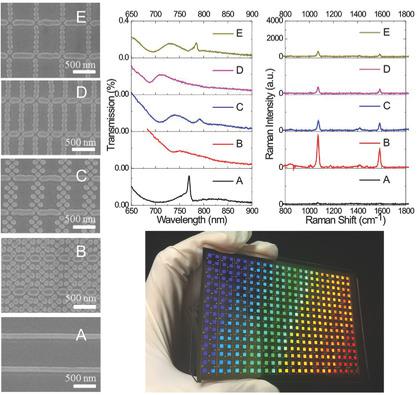当前位置:
X-MOL 学术
›
Adv. Mater. Interfaces
›
论文详情
Our official English website, www.x-mol.net, welcomes your
feedback! (Note: you will need to create a separate account there.)
Dual Sensing Arrays for Surface Plasmon Resonance (SPR) and Surface‐Enhanced Raman Scattering (SERS) Based on Nanowire/Nanorod Hybrid Nanostructures
Advanced Materials Interfaces ( IF 4.3 ) Pub Date : 2018-09-19 , DOI: 10.1002/admi.201801064 Kuang-Li Lee,Chia-Yu Hung,Ming-Yang Pan,Tsung-Yeh Wu,Sen-Yeu Yang,Pei-Kuen Wei
Advanced Materials Interfaces ( IF 4.3 ) Pub Date : 2018-09-19 , DOI: 10.1002/admi.201801064 Kuang-Li Lee,Chia-Yu Hung,Ming-Yang Pan,Tsung-Yeh Wu,Sen-Yeu Yang,Pei-Kuen Wei

|
A multifunctional sensing array with gold nanowire–nanorod hybrid nanostructures for dual detection of surface plasmon resonance (SPR) and surface‐enhanced Raman scattering (SERS) is presented. The cost‐effective and arrayed nanostructures are made simply onto plastic films using hot‐embossing nanoimprint lithography. Five different hybrid nanostructures are studied and compared by measuring SERS enhancement factor and SPR thickness sensitivity. The combination of nanowire and nanorod structures in specific arrangement and quantities of nanorods can not only enhance the SERS effect but also further increase the SPR thickness sensitivity. The area percentage of nanorods of 16.51% can achieve the highest SPR thickness sensitivity and 106 SERS enhancement. On comparison of the nanowire structure, the SERS signal and SPR thickness sensitivity of nanowire/nanorod hybrid nanostructure are increased up to 6 times and 2 times simultaneously. The estimated SERS enhancement factor and SPR thickness sensitivity are 2.82 × 106 and 0.74 (nm/nm), respectively. The enhanced sensitivity is attributed to the increased nanorods contributing to dense hot spots and the reduced SPR evanescent length caused by the localized surface plasmons. These results are verified by finite‐difference time‐domain (FDTD) calculations. Such low‐cost SPR–SERS chips for multifunctional chemical analysis can increase the reliability of biological detection and broaden sensing applications.
中文翻译:

基于纳米线/纳米棒混合纳米结构的表面等离子体共振(SPR)和表面增强拉曼散射(SERS)的双传感阵列
提出了一种具有金纳米线-纳米杂化纳米结构的多功能传感阵列,用于双重检测表面等离振子共振(SPR)和表面增强拉曼散射(SERS)。利用热压印纳米压印光刻技术,可以在塑料薄膜上简单地制造经济高效且排列整齐的纳米结构。通过测量SERS增强因子和SPR厚度灵敏度,研究并比较了五种不同的杂化纳米结构。纳米线和纳米棒结构的特定排列以及纳米棒的数量的结合不仅可以增强SERS效果,而且可以进一步提高SPR厚度灵敏度。纳米棒的面积百分比为16.51%,可以实现最高的SPR厚度灵敏度和10 6SERS增强。在比较纳米线结构时,纳米线/纳诺德杂化纳米结构的SERS信号和SPR厚度灵敏度分别提高了6倍和2倍。估计的SERS增强因子和SPR厚度灵敏度分别为2.82×10 6和0.74(nm / nm)。灵敏度的提高归因于纳米棒的增加导致密集的热点以及局部表面等离子体激元引起的SPR消失长度的减小。这些结果已通过时域有限差分(FDTD)计算得到了验证。这种用于多功能化学分析的低成本SPR–SERS芯片可以提高生物检测的可靠性并扩大传感应用范围。
更新日期:2018-09-19
中文翻译:

基于纳米线/纳米棒混合纳米结构的表面等离子体共振(SPR)和表面增强拉曼散射(SERS)的双传感阵列
提出了一种具有金纳米线-纳米杂化纳米结构的多功能传感阵列,用于双重检测表面等离振子共振(SPR)和表面增强拉曼散射(SERS)。利用热压印纳米压印光刻技术,可以在塑料薄膜上简单地制造经济高效且排列整齐的纳米结构。通过测量SERS增强因子和SPR厚度灵敏度,研究并比较了五种不同的杂化纳米结构。纳米线和纳米棒结构的特定排列以及纳米棒的数量的结合不仅可以增强SERS效果,而且可以进一步提高SPR厚度灵敏度。纳米棒的面积百分比为16.51%,可以实现最高的SPR厚度灵敏度和10 6SERS增强。在比较纳米线结构时,纳米线/纳诺德杂化纳米结构的SERS信号和SPR厚度灵敏度分别提高了6倍和2倍。估计的SERS增强因子和SPR厚度灵敏度分别为2.82×10 6和0.74(nm / nm)。灵敏度的提高归因于纳米棒的增加导致密集的热点以及局部表面等离子体激元引起的SPR消失长度的减小。这些结果已通过时域有限差分(FDTD)计算得到了验证。这种用于多功能化学分析的低成本SPR–SERS芯片可以提高生物检测的可靠性并扩大传感应用范围。











































 京公网安备 11010802027423号
京公网安备 11010802027423号